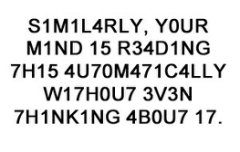5th semester, 3rd year
Teaching: 30 lectures and 15 seminars
Credits: 4+2
The course introduces students to the field of Text Linguistics. It compares and contrasts the two main branches of the discipline: Halliday’s socio-semiotic one, and de Beaugrande and Dressler’s mental structure-based approach. It also focuses on state-of-the-art cognitive theories of text-processing and discourse analysis.
Generally, the course aims to build on students’ previous linguistic knowledge. The seminars in particular aim to enhance students’ practical skills in analyzing, editing and creating texts. The course also seeks to enhance students’ professionalism in dealing with genres and text types.
SYLLABUS
• Text Linguistics. Place, Method, Evolution
• The Orality-Literacy continuum
• Text as a product vs. text as a process
• Cohesion (Halliday)
• Frames, Mental models, ICMs, Global patterns
• Prototypes and categorization
• Cohesion (de Beaugrande and Dressler)
• Coherence (de Beaugrande and Dressler)
• User-centered standards of textuality (de Beaugrande and Dressler)
• Text types and Overall Text Structure
• Cognitive text and discourse analyses
EVALUATION
1/3 Mid-term Test + 2/3 Final Exam
• Non-participation in the Mid-term Test amounts to 0 points to the Final Grade.
• The Final Exam has 2 components:
1) An open-ended question which does not follow the formulation of the Syllabus topics. Students will be required to provide their own opinion and argue their case.
2) A chunk of text for practical analysis.
READING
Basic:
Halliday, M.A.K. and R. Hasan. 1976. Cohesion in English. London: Longman
Beaugrande, R. de and Dressler, W. 1981. Introduction to Text Linguistics. Longman
Additional:
Brown, G and G. Yule. 1983. Discourse Analysis. Cambridge: Cambridge University Press.
Coulson, S. and T.Oakley. 2000. ‘Blending Basics’. In: Cognitive Linguistics, 11(3/4) pp. 175-196. Walter de Gruyter.
Coulson, S. 2001. Semantic Leaps: Frame-shifting and Conceptual Blending in Meaning Construction. New York and Cambridge: CUP.
Coulson, S. and T. Matlock. 2001. ‘Metaphor and the Space Structuring Model’. Metaphor and Symbol, 16, pp. 295–316.
Coulson, S. and T. Oakley. 2003. ‘Metonymy and Conceptual Blending’. In: Panther K. and L. Thornburg (eds.) Metonymy and Pragmatic Inferencing. Amsterdam/Philadelphia: John Benjamins Publishing Company.
De Beaugrande, R. 2004. A new introducton to the study of text and discourse. Available online: http://beaugrande.com/new_intro_to_study.htm
Evans, V. and M. Green, 2006. Cognitive Linguistics. An Introduction. Edinburgh: Edinburgh University press.
Fauconnier, G. and M. Turner. 2002. The Way We Think: Conceptual Blending and the Mind’s Hidden Complexities. New York: Basic Books
Fauconnier, G. 2014. ‘Mental spaces, language modalities, and conceptual integration’. In: Tomasello, M. and L. Erlbaum (eds.) The New Psychology of Language: Cognitive and Functional Approaches to Language Structure, (I), pp. 230-258. New York: Psychology Press
Feldman, J. 2006. From molecule to metaphor. A neural theory of language. Cambridge, Massachusetts and London, England: The MIT Press
Halliday, M.A.K. and R. Hasan. 1985. Language, Context, and Text: Aspects of Language in a Social-semiotic Perspective. Deakin University Press.
Lakoff, G. 1987. Women, Fire and Dangerous Things: What Categories Reveal About the Mind.
Lakoff, G. 2009. The Neural Theory of Metaphor. Cambridge: CUP.
Lakoff, G. 2012. Metaphor in Culture. Cambridge: CUP.
Langacker, R. 1987. Foundations of Cognitive Grammar. Vol. I. Stanford University Press.
Langacker, R. 1991. Foundations of Cognitive Grammar. Vol. II. Stanford University Press. Langacker, R. 1990. Concept, Image and Symbol. The cognitive basis of grammar. New York: Mouton de Gruyter.
Langacker, R. W. 2008. Cognitive Grammar: A Basic Introduction. New York: Oxford University Press.
Rosch, E. 1973. ‘Natural Categories’. Cognitive Psychology, 4, 328-50.
Rosch, E. 1975. ‘Cognitive Reference Points’. Cognitive Psychology, 7, 532-47.
Rosch, E. and C. Mervis. 1975. ‘Family Resemblances: studies in the internal structure of categories’. Cognitive Psychology 7, 573 – 605.
Taylor, J. 2004. Linguistic Categorization, 3rd edition. Oxofrd: OUP
Tincheva, N. 2012. Enter Text Linguistics. Sofia: DS Publ.
Van Dijk, T. 2008a. Discourse and Context. A sociocognitive approach. Cambridge: CUP.
Van Dijk, T. 2008b. Discourse and Power. Contributions to Critical Discourse Studies. Houndsmills: Palgrave MacMillan.
Van Dijk, T. 2009. Society and Discourse. How social contexts control text and talk. Cambridge: CUP.
Van Dijk, T. 2014. Discourse and Knowledge. A sociocognitive approach. Cambridge: CUP.
